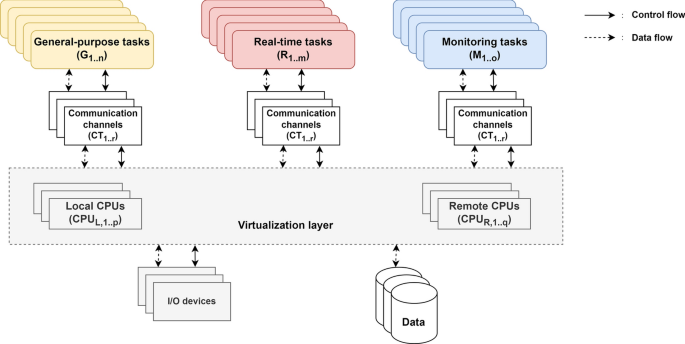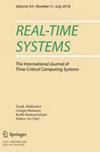评估混合临界系统中雾监测实时应用的虚拟化
IF 1.4
4区 计算机科学
Q3 COMPUTER SCIENCE, THEORY & METHODS
引用次数: 0
摘要
嵌入式系统的技术进步和雾计算的出现,提高了信息物理系统应用的服务质量。事实上,在功能强大的异构嵌入式系统(如多处理器片上系统(mpsoc))上部署此类应用程序,可以满足延迟要求和实时操作。与行业和我们的参考案例研究高度相关,核聚变的挑战性领域部署了上述应用,涉及具有硬实时性和安全性约束的高频控制。雾计算和mpsoc的使用有望实现这种控制的安全性、低延迟性和及时性。事实上,一方面,根据雾计算设计的应用程序将计算分布在分层组织和地理分布的边缘设备上,从而能够在时间序列的高频采样期间及时检测异常,另一方面,mpsoc允许利用雾计算并通过在适合混合临界软件的灵活平台上部署任务来集成监控,从而导致所谓的混合临界系统(mcs)。然而,在相同的MPSoC上集成此类软件会带来与可预测性和可靠性保证相关的挑战,因为在访问相同的共享MPSoC资源时,任务之间会相互干扰,可能会引入不确定性延迟,可能导致由于截止日期超时而导致失败。为了解决mpsoc上mcs的设计、部署和评估问题,我们提出了一个基于模型的系统开发过程,通过对mpsoc的设计和部署建模的形式化符号,促进了实时和监控软件在同一平台上的集成。建议的表示法允许开发人员利用嵌入式管理程序监视实时应用程序,并通过隔离硬件资源来保证可预测性。为了证明我们的系统开发过程的可行性,并评估核聚变应用的工业相关类别,我们在ITER核聚变反应堆的背景下进行了安全关键案例研究的实验。我们的实验包括在虚拟化MPSoC上作为mcs部署的几个原型的设计和评估,表明与监视器放置和虚拟化配置(例如,资源分配,分区和调度策略)相关的部署选择可以显著影响mcs在最坏情况下执行时间和其他相关指标方面的可预测性。本文章由计算机程序翻译,如有差异,请以英文原文为准。

Evaluating virtualization for fog monitoring of real-time applications in mixed-criticality systems
Abstract Technological advances in embedded systems and the advent of fog computing led to improved quality of service of applications of cyber-physical systems. In fact, the deployment of such applications on powerful and heterogeneous embedded systems, such as multiprocessors system-on-chips (MPSoCs), allows them to meet latency requirements and real-time operation. Highly relevant to the industry and our reference case-study, the challenging field of nuclear fusion deploys the aforementioned applications, involving high-frequency control with hard real-time and safety constraints. The use of fog computing and MPSoCs is promising to achieve safety, low latency, and timeliness of such control. Indeed, on one hand, applications designed according to fog computing distribute computation across hierarchically organized and geographically distributed edge devices, enabling timely anomaly detection during high-frequency sampling of time series, and, on the other hand, MPSoCs allow leveraging fog computing and integrating monitoring by deploying tasks on a flexible platform suited for mixed-criticality software, leading to so-called mixed criticality systems (MCSs). However, the integration of such software on the same MPSoC opens challenges related to predictability and reliability guarantees, as tasks interfering with each other when accessing the same shared MPSoC resources may introduce non-deterministic latency, possibly leading to failures on account of deadline overruns. Addressing the design, deployment, and evaluation of MCSs on MPSoCs, we propose a model-based system development process that facilitates the integration of real-time and monitoring software on the same platform by means of a formal notation for modeling the design and deployment of MPSoCs. The proposed notation allows developers to leverage embedded hypervisors for monitoring real-time applications and guaranteeing predictability by isolation of hardware resources. Providing evidence of the feasibility of our system development process and evaluating the industry-relevant class of nuclear fusion applications, we experiment with a safety-critical case-study in the context of the ITER nuclear fusion reactor. Our experimentation involves the design and evaluation of several prototypes deployed as MCSs on a virtualized MPSoC, showing that deployment choices linked to the monitor placement and virtualization configurations (e.g., resource allocation, partitioning, and scheduling policies) can significantly impact the predictability of MCSs in terms of Worst-Case Execution Times and other related metrics.
求助全文
通过发布文献求助,成功后即可免费获取论文全文。
去求助
来源期刊

Real-Time Systems
工程技术-计算机:理论方法
CiteScore
2.90
自引率
7.70%
发文量
15
审稿时长
6 months
期刊介绍:
Papers published in Real-Time Systems cover, among others, the following topics: requirements engineering, specification and verification techniques, design methods and tools, programming languages, operating systems, scheduling algorithms, architecture, hardware and interfacing, dependability and safety, distributed and other novel architectures, wired and wireless communications, wireless sensor systems, distributed databases, artificial intelligence techniques, expert systems, and application case studies. Applications are found in command and control systems, process control, automated manufacturing, flight control, avionics, space avionics and defense systems, shipborne systems, vision and robotics, pervasive and ubiquitous computing, and in an abundance of embedded systems.
 求助内容:
求助内容: 应助结果提醒方式:
应助结果提醒方式:


